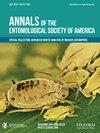形成社会黄蜂集体防御的进化和生态压力
IF 3
3区 农林科学
Q1 ENTOMOLOGY
引用次数: 8
摘要
摘要群居昆虫以其对巢穴干扰的攻击性(刺痛)反应而闻名。尽管如此,由于巢穴中的高蛋白幼崽,菌落还是会受到攻击。群居黄蜂进化出了各种防御机制来排斥捕食者,包括巢穴的构建和协调的刺痛反应。哪些掠夺性压力塑造了社会黄蜂为保护其群落而表现出的防御策略?我们回顾了文献,并探索了社交媒体,以比较捕食者攻击黄蜂个体和群落的直接和间接(声称和推断)证据。个体觅食黄蜂主要被鸟类和其他节肢动物捕食,而胡蜂窝中的捕食者在胡蜂亚科中各不相同。Politinae黄蜂主要被蚂蚁和雀形目鸟类捕食,而Vespinae黄蜂主要被獾、熊和鹰捕食。蚂蚁和大黄蜂是Stenogastrinae群落的主要捕食者。这五个主要捕食者目捕食的概率在各大洲各不相同。然而,猎物-捕食者趋势的生物地理变化最好通过气候(温带与热带)来预测。在社会黄蜂的进化史上,当群落很小时,捕食压力可能来自小型哺乳动物、蜥蜴或鸟类。随着群落进化出更大的规模和对捕食者的更大奖励,捕食压力的增加可能会导致更有效的防御反应。如今,大型黄蜂群落的主要捕食者似乎高度适应抵抗或避免攻击性的巢穴防御,如大型鸟类和哺乳动物(当黄蜂的真社会性进化时,它们还不存在)以及蚂蚁。本文章由计算机程序翻译,如有差异,请以英文原文为准。
Evolutionary and Ecological Pressures Shaping Social Wasps Collective Defenses
Abstract Social insects are well known for their aggressive (stinging) responses to a nest disturbance. Still, colonies are attacked due to the high-protein brood cached in their nests. Social wasps have evolved a variety of defense mechanisms to exclude predators, including nest construction and coordinated stinging response. Which predatory pressures have shaped the defensive strategies displayed by social wasps to protect their colonies? We reviewed the literature and explored social media to compare direct and indirect (claims and inferences) evidence of predators attacking individuals and colonies of wasps. Individual foraging wasps are predominantly preyed upon by birds and other arthropods, whereas predators on wasp brood vary across subfamilies of Vespidae. Polistinae wasps are predominantly preyed upon by ants and Passeriformes birds, whereas Vespinae are predominantly preyed upon by badgers, bears, and hawks. Ants and hornets are the primary predators of Stenogastrinae colonies. The probability of predation by these five main Orders of predators varies across continents. However, biogeographical variation in prey–predator trends was best predicted by climate (temperate vs. tropical). In social wasps' evolutionary history, when colonies were small, predation pressure likely came from small mammals, lizards, or birds. As colonies evolved larger size and larger rewards for predators, the increased predation pressure likely selected for more effective defensive responses. Today, primary predators of large wasp colonies seem to be highly adapted to resist or avoid aggressive nest defense, such as large birds and mammals (which were not yet present when eusociality evolved in wasps), and ants.
求助全文
通过发布文献求助,成功后即可免费获取论文全文。
去求助
来源期刊
CiteScore
4.90
自引率
0.00%
发文量
25
审稿时长
6-12 weeks
期刊介绍:
The Annals of the Entomological Society of America exists to stimulate interdisciplinary dialogue across the entomological disciplines and to advance cooperative interaction among diverse groups of entomologists. It seeks to attract and publish cutting-edge research, reviews, collections of articles on a common topic of broad interest, and discussion of topics with national or international importance. We especially welcome articles covering developing areas of research, controversial issues or debate, and topics of importance to society. Manuscripts that are primarily reports of new species, methodology, pest management, or the biology of single species generally will be referred to other journals of the ESA. The most important criteria for acceptance are quality of work and breadth of interest to the readership.

 求助内容:
求助内容: 应助结果提醒方式:
应助结果提醒方式:


